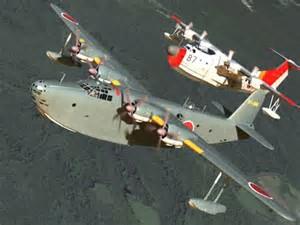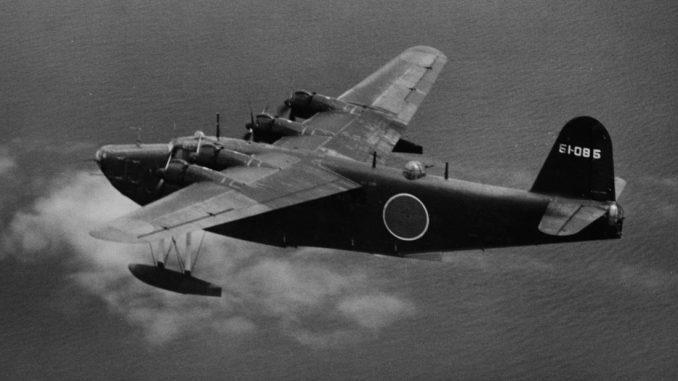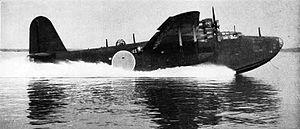A free template by Lucknowwebs.com for WYSIWYG WebBuilder 8
Powered by Sispro1-S
Nigel G Wilcox
Paragon Of Space Publication
© Copyright Reserved - United Kingdom
Ideal Screen Composition 1024 x 768
SITEMAP
SCIENCE RESEARCH
ABOUT
Desk
Supersonic
Stealth
MAIN INDEX
Sea-Air Planes
Kawanishi H8K Type 2
The Imperial Japanese Navy made extensive use of their long range flying boats in WW II. Their long range master was the Kawanishi H8K Type 2, a high performance, four-engined bomber, reconnaissance and transport aircraft code named "Emily" by the Allies. This was the best flying boat of the war with excellent performance, long range and good defensive armament. Emilys ranged the Pacific, providing valuable information about Allied movements and dispositions. They were also employed as long range bombers and Type 2 flying boats raided Honolulu, Hawaii in March 1942. Because of their long range, they were pressed into service as scouts for Japanese carrier striking forces, but they often suffered grievous losses at the hands of radar directed carrier-borne fighters when they approached U.S. task forces.
Unlike most Japanese aircraft, the H8K-2 incorporated armor protection for the crew and protected fuel tanks in the wings and fuselage. Defensive armament included single 20mm cannon in the nose turret, dorsal turret, tail turret and (port and starboard) beam blisters. These were augmented by five .303 machine guns firing from hull hatches. Offensive weapons included two torpedoes or 2205 pounds of bombs and depth charges. Performance was excellent, the best of any of the big WW II flying boats. Top speed was almost 300 mph at around 20,000' and the service ceiling was over 28,000'. After the Japanese developed radar, surface search sets were fitted to H8K patrol bombers.
The prototype H8K's first flight took place in January 1941 and the first production version was the H8K-1, Type 2, Model 11, which entered service early in 1942. 14 were completed before production shifted in 1942 to the definitive and considerably improved H8K-2, Type 2, Model 12. Improvements included up-rated engines, increased fuel capacity and a heavier defensive armament. 112 HK8-2's, the most numerous model, were built during WW II. Four survived the war and one of these was brought to the U.S. for evaluation after the war. This aircraft was returned to Japan in 1979 and can be seen today at the Kanoya Museum (Kanoya airfield), Kagoshima.
There was a transport version of the H8K, the H8K-2L, and 36 of these were built. Most of the defensive armament, including the side blisters and dorsal turret, was suppressed to increase the weight of troops and material it could carry. The fuselage fuel tanks were removed to increase its cargo volume. The result of these modifications was that the H8K-2L could transport up to 62 combat troops.
One of the important Japanese strategic oversights of the war was their failure to protect their merchant shipping. It is my opinion that far more extensive use should have been made of flying boats to protect the valuable convoys bringing raw materials to Japan from her far-flung conquered territories. American submarines sank about half of the entire Japanese merchant fleet with little interference from the air, yet air cover proved to be the most effective submarine deterrent of the war. The importance of the offensive operations that resulted in the destruction of Kawanishi flying boats at the hands of U.S. fighters pales in comparison to the service these aircraft could have performed protecting convoys from submarine attack. The traditional Japanese offensive spirit cost them dearly during the war. Following are some specifications for the H8K2 Type 2 flying boat, Model 12.
The Kawanishi H8K was an Imperial Japanese Navy flying boat used by the Imperial Japanese Navy Air Service during World War II for maritime patrol duties. The Allied reporting name for the type was "Emily".
Maximum speed: 465 km/h (288.94 mph) Range: 4,443 mi Maiden flight: Jan 1941 Length: 92.36 ft Wingspan: 124.67 ft Passengers: 64




General characteristics
Crew: 10
Length: 28.15 m (92 ft 4 in)
Wingspan: 38.00 m (124 ft 8 in)
Height: 9.15 m (30 ft)
Wing area: 160 m² (1,721 ft²)
Empty weight: 18,380 kg (40,436 lb)
Loaded weight: 24,500 kg (53,900 lb)
Max. takeoff weight: 32,500 kg (71,500 lb)
Powerplant: 4 × Mitsubishi Kasei 22 radial engines, 1,380 kW (1,850 hp) each
Performance
Maximum speed: 465 km/h (290 mph)
Range: 7,150 km (4,440 mi)
Service ceiling: 8,760 m (28,740 ft)
Rate of climb: 8.1 m/s (1,600 ft/min)
Wing loading: 153 kg/m² (31 lb/ft²)
Power/mass: 0.22 kW/kg (0.14 hp/lb
Armament
Guns:
5× 20 mm Type 99 cannon (one each in bow, dorsal, and tail turrets, plus one each in two waist blisters)
5× 7.7 mm (.303 in) Type 92 machine guns in fuselage hatches
Bombs: 2× 800 kg (1,764 lb) torpedoes or 2,000 kg (4,410 lb) of bombs or depth charges
Avionics
Mark VI Model 1 ASV radar

Role: Four engine long-range Flying boat
Manufacturer: Kawanishi
Designer: Shizuo Kikuhara
First flight: January 1941
Introduction: February 1942
Retired: 1945
Primary user: IJN Air Service
Produced: 1941-1945
Number built: 167
131 of Type 2 Flying boat
36 of Seiku
S'sonic
Stealth
Menu
Space
Transport
Menu
Topic
Menu
Study
Menu









